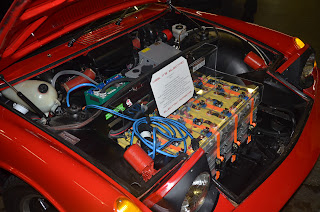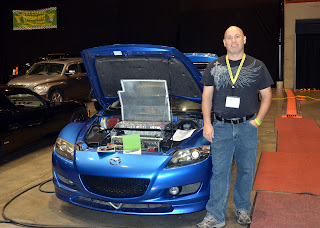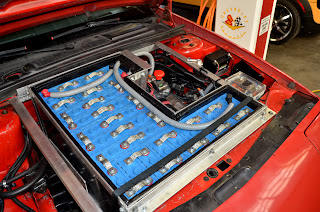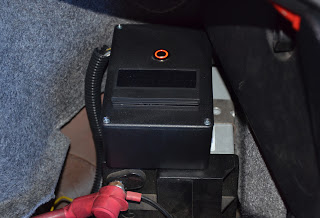EVCCON 2012
You may remember that my father and I took the Z3 out to Missouri last year for the inaugural EVCCON. It was a fantastic event and before it even ended, I decided that Dad and I would return to EVCCON 2012. There was a big difference this year in that we didn't take the car along with us. Having the car out there last year was terrific, but trailer-ing it out there was stressful, expensive, and it took three days each way. So this year the car waited back in the garage while we went to Missouri.
There has been plenty written of the convention on some very well written blogs, particularly on Mike Brown's blog about his Porsche 914 conversion, ( day 1, day 2 and day 3), and of course on EVTV. What I was most taken back by was the quality of the builds this year. I've been told by a number of people that they think I did a great job on the Z3. Compared to most conversions I've seen, it is great. Virtually all of the people that brought cars to this year's convention attended last year's and had a chance to see all of the cars that were brought at that time. There were a handful of car's at last years convention that made the Z3 look like a kindergarten project. It was evident by everyone that saw them, that they were clearly a different animal. In fact, it's clear that the community has decided those cars are the new standard. If you were going to convert a car, they were the benchmark that you need to aim for. A challenge that all took seriously.
The quality of the cars this year was simply outstanding. Everyone had all the components laid out and organized better than you'd expect an OEM to do. All of the wiring was routed perfectly and protected in looms. The connectors all neat and orderly, everything labeled. Looking in to these cars was like looking in jewelry boxes. Just astounding. Here's a sampling of a few. I wish I'd grabbed more photos.
 |
| Fred Behning and his MGTD |
 |
| Jeff Greeson's 914. Take away that blue cord and it's looks like a show piece. |
 |
| John Allen's Celica. A beautiful job in every respect. |
 |
| Kevin Heath and his RX8. He has every reason to be proud of this build. |
 |
| Jason Horack's Daytona. Well laid out, neat and tidy. |
 |
| Dale Friedhoff's Ranger. It won best wiring/layout award. |
If I'm not mistaken, last year Dad and I were the only father/son team at the convention. Well apparently that inspired a few others. Several decided they wanted to share the experience with their fathers as well. I was thrilled to see that list grow to 5 teams. We took a moment to pose in front of Jack Rickard's original Speedster, along with Jack.
 |
| Left to Right, Me, my dad Bill, John Allen and his father, Nabil Hanke , John Hanke, Jack Rickard, Fred Behning and his dad Fred, Brandon Hollinger and his father on the end. |
After a public car show in the park, the EVs went on parade through town and back to a local hotel were many of the attendees were staying. They rounded up all the EVs that were in the parade for a photo op.
I think there are 33 cars in the photo, and I know of 5 others that didn't make it. So that brings the total to 38 EVs at the convention by my count. Not a bad turnout. If you have the means to attend, I encourage you not to miss EVCCON 2013. They are only going to get better from here on out.
Charger News
You may remember from my last post that my charger up and exploded on me. It went back to Manzanita and they repaired it in a couple days and had it back to me right quick. I think the charger was out of the car for less than a week. All seemed well until a week after the install I noticed the charger behaving very erratically. Though I'd dialed in 20 amps of current, I saw the meter bounce all around from 18 to 2 then 10 then 3 then 5 amps. It was clear that it wasn't healthy.
I contacted Manzanita again and explained what it was doing. They asked me to take notes for a while to see if we could see a pattern to help them determine a cause. If there was a pattern somewhere buried in the data I gave them, it escaped me. After a couple weeks, we decided they needed it back to fix it. I took it out and mailed it the day before Dad and I left for EVCCON.
As it happens, Rich Rudman owner Manzanita Micro was one of the featured speakers at EVCCON, so I got to talk to him about the charger. I offered to let him pick my brain about it's behavior hoping that he might have some insight into why it was doing what it was doing. Instead it turned into a very short conversation. Rich asked me if it was behaving erratically, and listed off a few of the key characteristics of the behavior. I said "Yes! Exactly!" He said "Yeah... we don't know what's causing that." Apparently they've seen this a few times. They suspect a specific chip on the power board is causing it. When they come across this, they replace a few key components and that resolves the problem.
I got it back last Wednesday, they had it for about 2 weeks, and so far, I'd say they nailed it. It has been rock solid reliable. Boy, do I like that. They really are a first rate shop.
A Watchdog Circuit
It's happened twice now, which isn't a lot, but enough to make me a bit nervous. The charger which usually cuts off when the pack reaches 164.5 volts has error-ed during the constant voltage portion of the charge cycle. Instead of cutting off the charge in 10 minutes I set it for, it was well past 15 minutes, and I turned it off manually because the battery was going too high. I was present on both occasions to catch it and prevent it from over charging the batteries. But that begs the question, how many times did I not catch it because I wasn't there to watch?
The truth is, the charger is pretty reliable, but it uses electronic components to process that logic and is subject to the same faults any electronic component is. How many times does you computer do something unexpected? The world is an imperfect place. To that end, I've always thought that it would be worth while to have a separate circuit watching the charge cycle, one that had the ability to cut off the charge if things got out of hand. Fortunately a couple simple components allow anyone with a Manzanita Micro charger to do just that. I believe that other chargers have this capability as well, but I don't own any of them, so I can't say.
The Manzanita chargers were built incorporating what Manzanita calls the REG Bus. I hear it does many things when coupled with other hardware that they sell. But the truth is, I only need to use one of those functions, and that's the one that allows me to stop the charger.
Pin 1 on the REG Bus supplies 5 volts DC. Pin 2 has no voltage on it; however, if pin 2 sees 5 volts, the charger interprets this as an over charge condition and shuts the charging cycle off. The charger remains on, with the fans cooling it, but the charging cycle terminates. The bad side is, if you remove that 5 volts from pin 2, the charger immediately starts charging again. So the trick is to get pin 1 and 2 shorted under the right conditions and leave them connected until the over charge condition goes away. Enter the JLD 5740 volt meter. At $37.50, it's a bargain.
The 5740 will measure anything from 0 - 500 Volts, DC or AC should you need it. It has 2 relays that you can set independently. You can set a relay to latch closed at one voltage, and open at a different voltage. In this way, you can build in any logic for on/off you want. Here's how I set mine up.
When I turn the meter on, the relay is open. As the charge cycle runs, the voltage rises to the expected 164.5 volts. If for some reason, the charger misses it's target, the meter is set to close the relay at 165.2 volts. When the relay closes, the wire from pin 1 is shorted to the wire from pin 2 and the charger stops dead. That voltage is low enough that no cell in the system will exceed 3.6 volts. That relay then is latched closed until the voltage should drop below 158 volts. Since the resting voltage of the system, after a charge is 160, then the meter will never (without intervention) open that relay, and the charger will never restart.
When I built the car, I positioned a small switch under the charging door. When that door is open the switch sends 12 volts to the charger, and it's presumed that I'm charging and the car is plugged in. I run that 12 volt signal to the Zilla, which sees it and disables the car from moving. I've simply spliced into that line and use that signal to power a separate relay, that then powers the meter. I've incorporated the whole thing in a project box.
 |
| Notice the neat glowing switch on top of the box. |
 |
| The switch is depressed and the meter is on. |
I've run the power from the switch in the charging port to a second switch in the project box. If I want to use the meter to watch the charger, I simply press that button and the meter comes on. When I press the switch again, or if I close the charging port door, the meter is turned off. I don't need for it to be on when I'm not charging, so there's no reason to have that parasitic load running.
The only thing I haven't mentioned is that the 12V from the car that powers the meter first runs through a small 3 Watt DC to DC converter that isolates the high voltage on the meter from the car's 12V system. We don't want the high voltage system leaking back to the chassis. Pretty slick, and the whole thing cost less than $50 and it works great.
